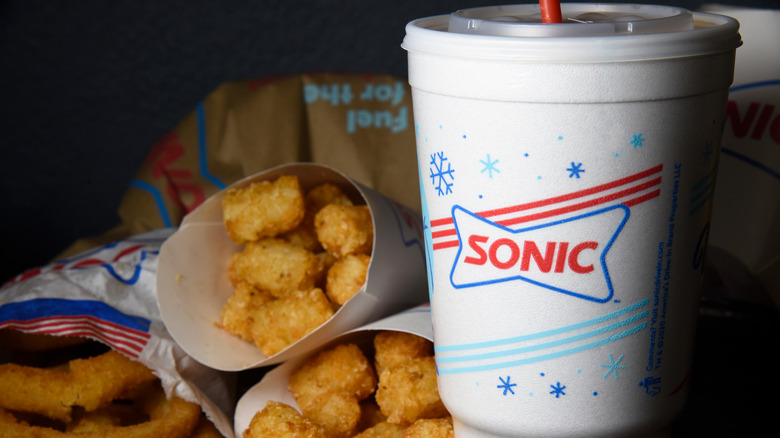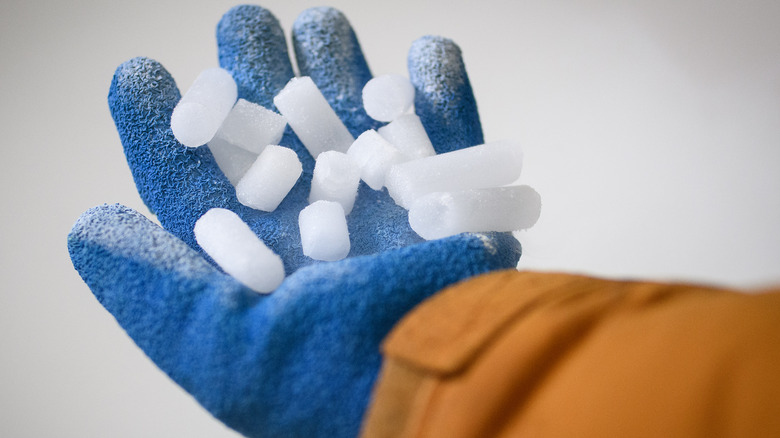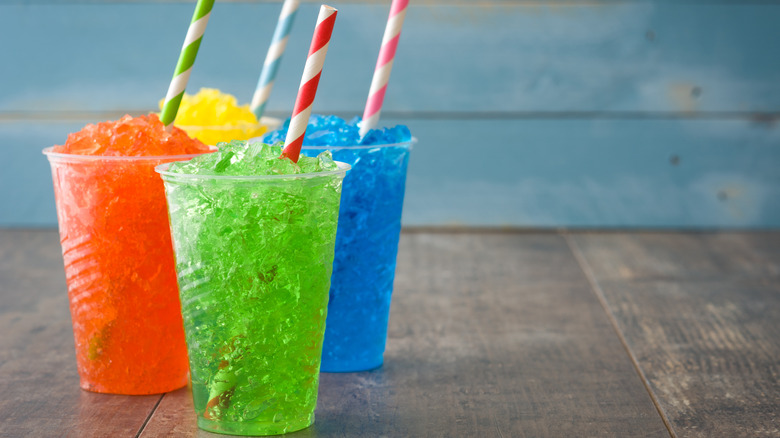What Makes Sonic's Ice Cubes Different
The recipe for ice isn't too complicated, you combine one part oxygen with two parts hydrogen and chill below 32 degrees Fahrenheit until solid. However, many ice connoisseurs will attest that not all ice is the same. Depending on the intended use of ice, one must consider size, shape, consistency, and even clarity. For an old fashioned or a whiskey on the rocks, the preferred ice style is one clear, crystalline cube or sphere, says The Whiskey Wash, or sometimes even a hand-carved polyhedron. Chilling large volumes of liquid in a pitcher or ice bath may require ice cubes produced in a commercial setting. But if you're in the mood for something refreshing, and perhaps plan on noshing on the ice after the drink is finished, then you know that Sonic ice is the unequivocal best, says GQ.
According to Easy Ice, Sonic ice refers to the style of ice popularized by Sonic Drive-In, the fast food chain known for its '50s-style carhop service, crispy tater tots, and cherry limeade slushes. Also known as nugget, pebble, pellet, or chewable ice, Sonic ice is among the most sought-after and versatile styles of frozen water on the market — but what makes Sonic ice so different, and why is it the preferred beverage coolant for ice chewers everywhere?
Sonic ice vs. crushed ice
At first glance, it may seem like Sonic ice is just a type of crushed ice, a common misconception that couldn't be further from the truth. In actuality, the two take completely opposing approaches to solidifying water. Let's start with breaking down the production of conventional crushed ice. As explained by Easy Ice, a traditional ice maker features water that is run over a cold metal plate in a mold, causing the water to crystalize into a solid, rock-like cube. When ready, the cube is released from the mold and collected in the ice crusher where the ice is broken into smaller shards and chunks.
Easy Ice goes on to explain how Sonic ice, on the other hand, starts by using a cold metal cylinder that condenses water around it to form a thin sheet of ice on the inner surface. The frost is scraped off the cylinder by a drill-like auger system to make flaked ice. This flaked ice is then collected, compressed, and reformed into pellets or nuggets. Because it doesn't form as a singular, uniform solid block of ice, compact shaved ice has a looser structure. This makes nugget ice softer, chewier, and more absorbent than its crushed counterpart, according to Better Home & Living.
The good, the bad, and the icy
When fans attest to the preeminence of nugget ice, it's usually in reference to how easily consumed it is. As you fill a glass with nugget ice and liquid, the ice actually soaks up some of the beverage, contrary to the more impregnable cubes and crushed ice. Subsequently, the saturated nugget ice softens, making it not only easier to chew, but tastier for snacking long after the drink is gone (and the slight crunch can even add to the sensory experience while you're drinking). Better Home & Living goes on to praise nugget ice for being less harsh on your teeth and better for equal ice distribution.
Some of its detractors at Eater may call it overrated, lampooning the space it takes up and its relatively quick melting time. Admittedly, nugget ice might have shortcomings in terms of coldness longevity (partly because it absorbs some of the liquid around it), but its expediency for cooling is top-tier due to the increased surface area to volume ratio.
All of the unique features that make Sonic ice so different can be credited to the novel method by which nugget ice is formed: This style seems tailor-made to absorb and complement Sonic's insane variety of drinks and invigorating signature slush flavors. As ice-heads everywhere can attest, the innovation of nugget ice has elevated the beverage industry as it continues setting the standard for premium refreshment.


